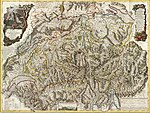Switzerland in the Napoleonic era: Difference between revisions
startted to expand article |
expanded fall of ancien regime |
||
| Line 15: | Line 15: | ||
==Fall of the Ancien Régime== |
==Fall of the Ancien Régime== |
||
During the last years of the Ancien Régime the growing conflicts throughout the Confederation (aristrocratic cities against peasant farmers, protestant against catholic and canton against canton) had weakened and distracted the Diet. In Paris the Helvetian Club, founded in 1790 by several exiled [[Vaud|Vaudois]] and [[Fribourg|Fribourgers]], was the centre from which the ideas of the French Revolution were in the western part of the Confederation. During the next eight years revolts sprang up across the Confederation and unlike earlier many were successful. In 1790 the Lower [[Valais]] rose against the upper districts. In 1791 [[Porrentruy]] rebelled against the [[Roman Catholic Diocese of Basel|Bishop of Basel]] and became the ''Rauracian republic'' in November 1792 and in 1793 the French department of the Mont Terrible. In 1795 [[St Gallen]] successfully revolted against the prince-abbot. |
During the last years of the [[Early Modern Switzerland|Ancien Régime]] the growing conflicts throughout the Confederation (aristrocratic cities against peasant farmers, protestant against catholic and canton against canton) had weakened and distracted the [[Tagsatzung|Diet]]. In Paris the Helvetian Club, founded in 1790 by several exiled [[Vaud|Vaudois]] and [[Fribourg|Fribourgers]], was the centre from which the ideas of the [[French Revolution]] were spread in the western part of the Confederation<ref name=EB>{{cite encyclopedia |
||
| title = Switzerland |
|||
| encyclopedia = Encyclopædia Britannica |
|||
| volume = 26 |
|||
| pages = 257 |
|||
| date = 1911 |
|||
| url = http://en.wikisource.org/wiki/1911_Encyclop%C3%A6dia_Britannica/Switzerland/History/Religious_divisions |
|||
| accessdate = 2008-10-05 }}</ref>. During the next eight years revolts sprang up across the Confederation and unlike earlier many were successful. In 1790 the Lower [[Valais]] rose against the upper districts. In 1791 [[Porrentruy]] rebelled against the [[Roman Catholic Diocese of Basel|Bishop of Basel]] and became the ''Rauracian republic'' in November 1792 and in 1793 the French department of the Mont Terrible. In 1795 [[St Gallen]] successfully revolted against the prince-abbot. These revolts were supported or encouraged by France, but the [[French Revolutionary Army|French army]] didn't directly attack the Confederation. |
|||
However, following the success of the [[First Coalition]] (1792-1797) against the aristrocratic armies of Prussia and Austria, the time had come for direct action against the aristrocratic Ancien Regime in Switzerland. In 1797 the districts of [[Chiavenna]], [[Valtellina]] and [[Bormio]], dependencies of the [[Three Leagues]] (an associate of the Confederation), revolted under the encouragement of France. They were quickly invaded and annexed to the [[Cisalpine Republic]] on October 10, 1797. In December of the same year the Bishopric of Basel was occupied and annexed<ref>{{HDS|9797-3-1|Helvetic Republic}}</ref>. |
|||
==References== |
|||
{{reflist}} |
|||
==See also== |
==See also== |
||
Revision as of 21:00, 5 October 2008
| History of Switzerland |
|---|
 |
| Early history |
| Old Swiss Confederacy |
|
| Transitional period |
|
| Modern history |
|
| Timeline |
| Topical |
|
|


During the French Revolutionary Wars, the revolutionary armies boiled eastward, enveloping Switzerland in their battles against Austria. In 1798 Switzerland was completely overrun by the French and became the Helvetic Republic. The Helvetic Republic encountered severe economic and political problems. In 1798 the country became a battlefield of the Revolutionary Wars, culminating in the Battles of Zürich in 1799.
In 1803 Napoleon's Act of Mediation reestablished a Swiss Confederation that partially restored the sovereignty of the cantons, and the former tributary and allied territories of Aargau, Thurgau, Graubünden, St. Gallen, Vaud and Ticino became cantons with equal rights.
The Congress of Vienna of 1815 fully re-established Swiss independence and the European powers agreed to permanently recognise Swiss neutrality. At this time, the territory of Switzerland was increased for the last time, by the new cantons of Valais, Neuchâtel and Geneva.
The Restoration, the time leading up to the Sonderbundskrieg, was marked with turmoil, and the rural population struggling against the yoke of the urban centres, for example in the Züriputsch of 1839.
Fall of the Ancien Régime
During the last years of the Ancien Régime the growing conflicts throughout the Confederation (aristrocratic cities against peasant farmers, protestant against catholic and canton against canton) had weakened and distracted the Diet. In Paris the Helvetian Club, founded in 1790 by several exiled Vaudois and Fribourgers, was the centre from which the ideas of the French Revolution were spread in the western part of the Confederation[1]. During the next eight years revolts sprang up across the Confederation and unlike earlier many were successful. In 1790 the Lower Valais rose against the upper districts. In 1791 Porrentruy rebelled against the Bishop of Basel and became the Rauracian republic in November 1792 and in 1793 the French department of the Mont Terrible. In 1795 St Gallen successfully revolted against the prince-abbot. These revolts were supported or encouraged by France, but the French army didn't directly attack the Confederation.
However, following the success of the First Coalition (1792-1797) against the aristrocratic armies of Prussia and Austria, the time had come for direct action against the aristrocratic Ancien Regime in Switzerland. In 1797 the districts of Chiavenna, Valtellina and Bormio, dependencies of the Three Leagues (an associate of the Confederation), revolted under the encouragement of France. They were quickly invaded and annexed to the Cisalpine Republic on October 10, 1797. In December of the same year the Bishopric of Basel was occupied and annexed[2].
References
- ^ "Switzerland". Encyclopædia Britannica. Vol. 26. 1911. p. 257. Retrieved 2008-10-05.
- ^ Helvetic Republic in German, French and Italian in the online Historical Dictionary of Switzerland.Error in template * invalid parameter (Template:HDS): "1"
